Traditional Catholic Prayers: Gog and Magog of the Evil Mountain of the North, Yamantau

From Link: Cabala - Qabalah, Freemasonry, the Tijaniyah Order, the Muslim Brotherhood, Al Qaeda, and Sufism
And Qabalah continues in it’s Devil’s work. Note this concerning the below, in Islam, freemasonry and all connected to it, is considered heresy and not part of confession of Allah. Muslims call freemasonry a "hawk" which means exactly that it is heresy and wrong. Traditional Catholics agree with Muslims on this. Both Catholics and Muslims worship the true God. In the below, the various movements are shown that were used as the base for the Sabatae Zvi Frankists of the Donmeh (who subverted Turkey and caused the genocide against the Armenian Christians). The Sabatae Zvi Frankists of the Donmeh are, with the Gnostic O.T.O., a huge part of the Freemasonic influence that utterly controls the Zionist Vatican. The Sabatae Zvi Frankists of the Donmeh are the religious core and base for all Likkud and all other Talmudic Zionism in Occupied Palestine (falsely called "Israel") and throughout the world. This Zionism of the Sabatae Zvi Frankists of the Donmeh is the prime mover behind the movements leading to the Kurdish Peshmergas' attacks on the Iraqi East Assyrian Churches and the Iranian Shi'ite militias attacks in Iraq and every other assassin horror in the region. Tikun Olam is the base of Cabala and the base of the Satanic Jew Zionist Cabalistic Talmudism.
Note: Sufism itself is not a heresy in Islam, but there is heretical teaching that calls itself Sufism that Islam does condemn, and that is the kind of false Sufism used by the Frankist Donmeh.
___________________________________________
Qabalah, Freemasonry, the Tijaniyah Order, the Muslim Brotherhood, Al Qaeda, and Sufism
The Secret Doctrine of the Assassins
An Occult Religion behind an Islamist fascade
miko's blog: Israel's Nuclear Weapons Program
Which leads to this in Russia. Or did it come from an earlier version of this? See Yamantau following.

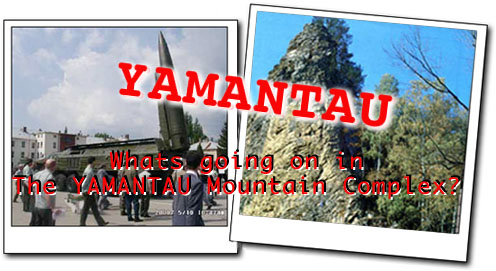
"In a secret project reminiscent of the chilliest days of the Cold War, Russia is building a mammoth underground military complex in the Ural Mountains, Western officials and Russian witnesses say.The complex, being built inside Yamantau mountain by tens of thousands of workers, covers an area the size of the Washington area inside the Beltway.
"Hidden inside Yamantau mountain in the Beloretsk area of the southern Urals, the project involved the creation of a huge complex, served by a railroad, a highway, and thousands of workers."
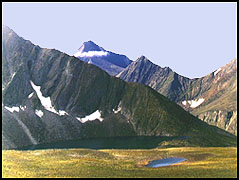 It is now known that the Soviet Union used secret underground bases in Eastern Europe to conceal nuclear missiles at the end of the Cold War, as an integral part of its nuclear war-fighting strategy. In all, some 73 SS-23 missiles, packing a nuclear punch 365 times the bomb that detonated over Hiroshima, were hidden by the Soviets in violation of the INF Treaty, which went into force in June 1988.
It is now known that the Soviet Union used secret underground bases in Eastern Europe to conceal nuclear missiles at the end of the Cold War, as an integral part of its nuclear war-fighting strategy. In all, some 73 SS-23 missiles, packing a nuclear punch 365 times the bomb that detonated over Hiroshima, were hidden by the Soviets in violation of the INF Treaty, which went into force in June 1988.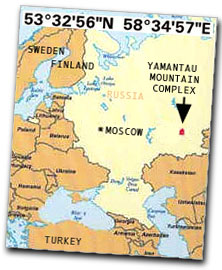 This declassified Defense Intelligence Agency map [right] shows the relative location of the underground Yamantau Mountain complex. Since the end of the Cold War in 1991, U.S. intelligence sources believe the Russian government has pumped more than$6 billion into Yamantau alone, to construct a sprawling underground complex that spans some 400 square miles.
This declassified Defense Intelligence Agency map [right] shows the relative location of the underground Yamantau Mountain complex. Since the end of the Cold War in 1991, U.S. intelligence sources believe the Russian government has pumped more than$6 billion into Yamantau alone, to construct a sprawling underground complex that spans some 400 square miles."a very large complex -- we estimate that it has millions of square feet available for underground facilities. We don't have a clue as to what they're doing there."It is believed to be large enough to house 60,000 persons, with a special air filtration system designed to withstand a nuclear, chemical or biological attack. Enough food and water is believed to be stored at the site to sustain the entire underground population for months on end."The only potential use for this site is post-nuclear war..." --- Rep. Roscoe Bartlett
Bartlett is one of the handful of members of Congress who have closely followed the Yamantau project.
The Yamantau Mountain complex is located close to one of Russia's remaining nuclear weapons labs, Chelyabinsk-70, giving rise to speculation it could house either a nuclear warhead storage site, a missile base, a secret nuclear weapons production center, a directed energy laboratory or a buried command post. Whatever it is, Yamantau was designed to survive a nuclear war.
In response to repeated U.S. inquiries, the Russian government has provided no fewer than 12 separate and contradictory explanations for the site, none of them believed to be credible.
A 1997 Congressional Research Service report said that the vast sums invested to build the Yamantau Mountain complex "provide evidence of excessive military modernization in Russia." Russia is pouring money into this and other underground nuclear sites at the same time U.S. taxpayers have provided billions of dollars in aid to Russia to help dismantle nuclear warheads taken off line as a result of START I and START II.
"Yamantau Mountain is the largest nuclear-secure project in the world... They have very large train tracks running in and out of it, with enormous rooms carved inside the mountain. It has been built to resist a half dozen direct nuclear hits, one after the other in a direct hole. It's very disquieting that the Russians are doing this when they don't have $200 million to build the service module on the international space station and can't pay housing for their own military people," ---Rep. Bartlett.
The Russians have constructed two entire cities over the site, known as Beloretsk 15 & 16, which are closed to the public, each with 30,000 workers. No foreigner has ever set foot near the site. A U.S. military attache stationed in Moscow was turned back when he attempted to visit the region a few years ago.
Neither the Central Intelligence Agency nor the Defense Intelligence Agency will comment on what the Russians are doing at Yamantau Mountain.
"There's not a lot we could say without venturing into the classified realm," CIA spokesman Mike Mansfield said. "It's hard to discuss it with any specificity."
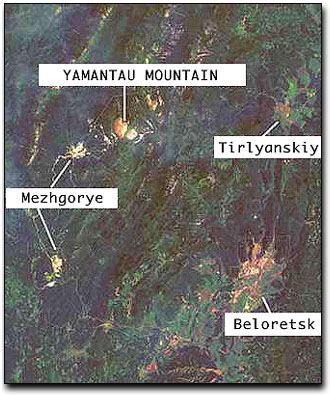 This U.S. satellite photograph of the Yamantau Mountain [left] region was taken on Oct. 16, 1997. Clearly recognizable signs of excavation can be seen at the areas marked Yamantau Mountain and Mezhgorye. Two above-ground support cities, each housing 30,000 workers, are located at Beloretsk and Tirlyanskiy.
This U.S. satellite photograph of the Yamantau Mountain [left] region was taken on Oct. 16, 1997. Clearly recognizable signs of excavation can be seen at the areas marked Yamantau Mountain and Mezhgorye. Two above-ground support cities, each housing 30,000 workers, are located at Beloretsk and Tirlyanskiy.The very little that is known publicly about the site comes from Soviet-era intelligence officers, who defected to Great Britain and the United States. In public testimony before a House Armed Services Subcommittee last October, KGB defector Col. Oleg Gordievsky said the KGB had maintained a separate, top-secret organization, known as Directorate 15, to build and maintain a network of underground command bunkers for the Soviet leadership -- including the vast site beneath Yamantau Mountain.
"And what is interesting was that President Yeltsin and Russia's new democratic leaders are using those facilities, and the same service is still running the same facility, like it was 10, 15 years ago." --- Col. Oleg Gordievsky
Yamantau Mountain is so secret that only a handful of Russian government officials knows about it, says Rep. Curt Weldon, R-Pa., who speaks Russian and travels frequently to Russia, chairing a congressional working group that discusses strategic issues with counterparts from the Russian Duma.
"I ask the Russians about it every time I meet with them... We've never had a straight answer."
Weldon got interested in Yamantau Mountain in 1995 when he saw a public report suggesting it was a vast mining project.
"I went to Moscow and spoke with the deputy interior minister who was in charge of mining," Weldon says. "I asked him if there was any mining activity there. He just shook his head and said he had never heard of it. So I mentioned the other name the Russians use for it: Mezhgorye. He said he hadn't heard of that either. Then he sent an aide out to check. Twenty minutes later, the aide came back, visibly shaken. He said they couldn't say anything about it."
Weldon also met with Andrei Kokoshkin, a former deputy defense minister, in charge of President Yeltsin's National Security Council.
"Kokoshkin called it a public works project, and said there was nothing to worry about, since the Defense Ministry had no involvement in it. So I brought out a copy of the Defense Ministry's budget -- it's only a few pages long -- and showed him the line item for Mezhgorye. He smiled and said it must be for bridges, roads and schools. When I then asked if I could see it, he said that could only be arranged through Yeltsin. The site was controlled directly by the president."
Weldon then tried sending a 3-page letter to Yeltsin in Russian.
"I told him all the things I was trying to do to foster better U.S.-Russia understanding, but said that I couldn't help if they couldn't clear up something as important as this. He never replied."
Where's the Money Coming From?
The cause for concern is that the US is currently sending hundreds of millions of dollars to Russia, supposedly to help that country dismantle old nuclear weapons. Meanwhile, the Russian parliament has been complaining that it cannot pay $250 million in back wages owed to its workers at the same time that it is spending money to comply with new strategic arms reduction treaties.
Aviation Week and Space Technology reported that "It seems the nearly $30 billion a year spent on intelligence hasn't answered the question of what the Russians are up to at Yamantau Mountain in the Urals. The huge underground complex being built there has been the object of U.S. interest since 1992. 'We don't know exactly what it is,' says Ashton Carter, the Pentagon's international security mogul. The facility is not operational, and the Russians have offered 'nonspecific reassurances' that it poses no threat to the U.S."
The following is an excerpt from an interview between Chris Ruddy and Col. Stanislav Lunev, a Russian military intelligence officer who defected in 1992.†Col. Stanislav Lunev is the highest-ranking military intelligence officer ever to have defected from Russia.
You ask about Yamantau Mountain.†Well, this is a huge underground city, which could be used in time when many Russian cities are destroyed, but the military and political elite will survive and live until our planet will try to restore itself.
U.S. law states that the Administration must certify to Congress that any money sent to Russia is used to disarm its nuclear weapons. However, is that the case? If the Russian parliament is complaining of a shortage of funds for nuclear disarmament, then how can Russia afford to build the Yamantau complex?
Could American funds be subsidizing a Russian weapons factory? A "doomsday" shelter? Or possibly something even more sinister? We'd like to hear YOUR opinion. Write tomyristicin@hotmail.com.
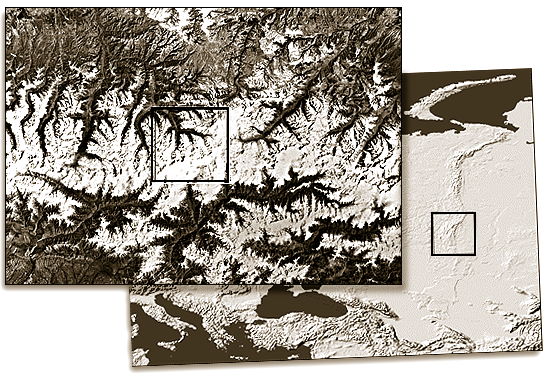
The Ural Mountains, which are also called the Stone Belt, extend for 2500 km from the hot Kazakh steppes to the frozen coast of the Arctic Ocean. Geographers divide the Urals into five regions: South, Middle, North, Subarctic and Arctic Urals. The widest part of the Urals is called the South Urals, and comprises dozens of parallel ridges, bounded in the north and in the south by the valleys of Ufalei River and Ural River respectively. Steppe and forest-steppe landscapes are typical of the foothills in this part of the Urals. Higher in the mountains, the hillsides are covered with mixed forests and the highest peaks, like islands, emerge among the green ocean of forest. The highest mountains of the South Urals - Yamantau (1640 m) and Bolshoi Ieremele (1582 m) - are located in the western row of ridges. |
http://viewzone2.com/yamantau.html
Description
Source
Description
Speakers
Further reading
External links
- Swadesh list
- Bashkir language's study
- "Bashkir Byki Deluxe 4" software
- Machine fund of the Bashkir language
- Russian-Bashkir dictionary online
- Bashkir-Russian & Russian-Bashkir dictionaries online
- Bashkir-Deutsch & Deutsch-Bashkir dictionaries online













No comments:
Post a Comment